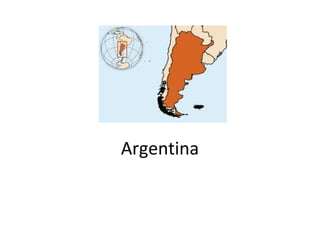
Notes de l'éditeur
- Area: 2.8 million sq. km. (1.1 million sq. mi.); about the size of the U.S. east of the Mississippi River; second-largest country in South America and eighth-largest country in the world.
- The city of Buenos Aires is the financial, industrial, commercial, and cultural hub of Argentina. The port is one of the busiest ports in South America. Buenos Aires ( /ˈbweɪnəs ˈɛəriːz/ or /ˈaɪrɪs/,[5] Spanish: [ˈbwenos ˈaiɾes]) is the capital and largest city of Argentina, and the second-largest metropolitan area in South America, after Greater Sao Paulo.[6] It is located on the western shore of the estuary of the Río de la Plata, on the southeastern coast of the South American continent. Greater Buenos Aires conurbation, which also includes several Buenos Aires Province districts, constitutes the third-largest conurbation in Latin America, with a population of around thirteen million.[3]
- It features three stripes alternating cerulean blue - white. Each stripe is 30 centimeters high. In the center stripe there is an emblem known as the Sun of May (Spanish: Sol de Mayo), a golden sun. The Sun is modeled after the symbol of Inti, the Incan god of the Sun. Popular belief attributes the colors to those of the sky, clouds and the sun; some anthems to the flag like "Aurora" or "Salute to the flag" state so as well.
- The official religion of Argentina is the Roman Catholic Church. Nevertheless, Argentina recognizes the freedom of religion, and you can easily find Synagogues, Mosques and most other places of worship of different creeds.
- Argentina experiences all four seasons, though at the opposite times of year as in the Northern Hemisphere. Winter officially begins on June 21 and goes until September 20, with an average temperature of 46 F (8°C). July is the coldest month. Summer officially begins on December 21 and ends on March 20, with an average temperature of 76 F (23°C). Between January and February the temperature has been known to reach 110 F (40°C), though this is rare. The humidity level varies between 75% and 90%, and while there is no specific rainy season, rains are more frequent during the spring and autumn months.
- In spite of the great figures of Porteño people, Buenos Aires cuisine is far away from the world´s healthiest. It has the best of Europe mixed with their Gaucho routes and their irresistible recipes high on proteins are the temptation of any tourist and almost a nightmare for vegetarians. Vegetables and fruits are available but usually more expensive and less popular than meat. Grilled meat like the asado is the staple of their diet. Steak is the specialty, but pastas, pizzas and empanadas are also part of their Italian heritage. Their favorite drink is a traditional infusion prepared with Yerba Mate, a bitter herb that contains stimulants similar to caffeine. This is often combined with baked doughnut-like pastries of German origin called facturas.
- Buenos Aires cultural diversity is evident in the people s faces, manners and habits. This versatility is product of government encouragement to European immigration during the 18th century, which brought mainly Spanish, Italian British, Jewish and German settlers, among other ethnic groups.
- María Eva Duarte de Perón was the second wife of President Juan Perón and served as the First Lady of Argentina from 1946 until her death in 1952. She is usually referred to as Eva Perón, or by the affectionate Spanish language diminutive Evita. Ernesto "Che" Guevara (Spanish pronunciation: [ˈtʃe ɣeˈβaɾa];[7] June 14,[1] 1928 – October 9, 1967), commonly known as el Che or simply Che, was an Argentine Marxist revolutionary, physician, author, intellectual, guerrilla leader, diplomat, and military theorist. A major figure of the Cuban Revolution, his stylized visage has become a ubiquitous countercultural symbol of rebellion and global insignia within popular culture.[8]
- Tango was born in the working-class neighborhoods of Buenos Aires, Argentina in the late 19th century. It first sprang to life in the brothels of Buenos Aires where the girls danced with their clients. It soon gained popularity with more established circles and moved to dancing houses where it was quickly absorbed into mainstream society.
- fertile plains of the pampas, lead, zinc, tin, copper, iron ore, manganese, petroleum, uranium Argentina has abundant natural and agricultural resources. 73 percent of its lands are rich of mineral resources such as Copper, Silver, Gold, Manganese and Antimony in addition to natural gas. Forests cover an area of 3,60 million hectares.
- The Pampas are plains in South America temperate climate that is tropical has four seasons
- The 20th century Argentina thus became an alloyance of races and cultures producing the interweaving of a complex identity that progressively became a feature of the Argentine people. Tango, soccer, political passions were only some of the cultural productions which spoke of a project worked out within a sea of conflicting ideologies and habits, but with the will to create a country as stated by the preamble of the National Constitution: "for all the honorable men who wish to inhabit the Argentine land". who brought progress in their baggage, but also syphilis and gunpowder. Spanish conquered Argentina
